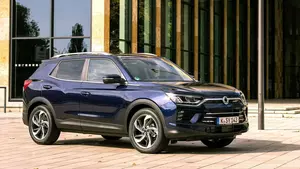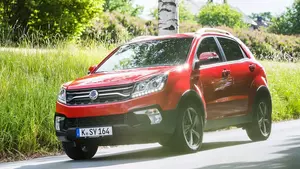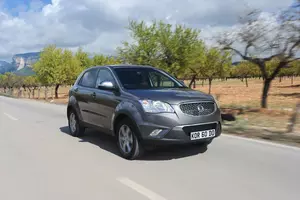
| Vehicle | Curb weight | Difference from world's smallest | Weight to power ratio | 0—60 mph acceleration ratio | Consumption ratio |
|---|---|---|---|---|---|
| 1.5 T-GDI |
1620 kg / 3572 lbs |
1195 kg (2635 lbs) heavier | 10 kg to 1 hp | - |
195 kg/L (430 lbs/L) |
| 2.0 MPI |
1465 kg / 3230 lbs |
1040 kg (2293 lbs) heavier | 10 kg to 1 hp | - | - |
| 1.6d |
1700 kg / 3749 lbs |
1275 kg (2812 lbs) heavier | 13 kg to 1 hp | - |
262 kg/L (578 lbs/L) |
| Vehicle | 1.5 T-GDI |
|---|---|
| Curb weight |
1620 kg / 3572 lbs |
| Difference from world's smallest | 1195 kg (1195 lbs) heavier |
| Weight to power ratio | 10 kg to 1 hp |
| 0—60 mph acceleration ratio | - |
| Consumption ratio |
195 kg/L (430 lbs/L) |
| Vehicle | 2.0 MPI |
| Curb weight |
1465 kg / 3230 lbs |
| Difference from world's smallest | 1040 kg (1040 lbs) heavier |
| Weight to power ratio | 10 kg to 1 hp |
| 0—60 mph acceleration ratio | - |
| Consumption ratio | - |
| Vehicle | 1.6d |
| Curb weight |
1700 kg / 3749 lbs |
| Difference from world's smallest | 1275 kg (1275 lbs) heavier |
| Weight to power ratio | 13 kg to 1 hp |
| 0—60 mph acceleration ratio | - |
| Consumption ratio |
262 kg/L (578 lbs/L) |

| Vehicle | Curb weight | Difference from world's smallest | Weight to power ratio | 0—60 mph acceleration ratio | Consumption ratio |
|---|---|---|---|---|---|
| 2.0 e-XGi |
1630 kg / 3594 lbs |
1205 kg (2657 lbs) heavier | 11 kg to 1 hp | - |
204 kg/L (450 lbs/L) |
| 2.2 e-XDi |
1795 kg / 3958 lbs |
1370 kg (3021 lbs) heavier | 10 kg to 1 hp | - |
309 kg/L (681 lbs/L) |
| Vehicle | 2.0 e-XGi |
|---|---|
| Curb weight |
1630 kg / 3594 lbs |
| Difference from world's smallest | 1205 kg (1205 lbs) heavier |
| Weight to power ratio | 11 kg to 1 hp |
| 0—60 mph acceleration ratio | - |
| Consumption ratio |
204 kg/L (450 lbs/L) |
| Vehicle | 2.2 e-XDi |
| Curb weight |
1795 kg / 3958 lbs |
| Difference from world's smallest | 1370 kg (1370 lbs) heavier |
| Weight to power ratio | 10 kg to 1 hp |
| 0—60 mph acceleration ratio | - |
| Consumption ratio |
309 kg/L (681 lbs/L) |

| Vehicle | Curb weight | Difference from world's smallest | Weight to power ratio | 0—60 mph acceleration ratio | Consumption ratio |
|---|---|---|---|---|---|
| 2.2 e-XDi |
1754 kg / 3868 lbs |
1329 kg (2931 lbs) heavier | 10 kg to 1 hp | - |
274 kg/L (604 lbs/L) |
| 2.0 e-XGi |
1612 kg / 3554 lbs |
1187 kg (2617 lbs) heavier | 11 kg to 1 hp | - |
215 kg/L (474 lbs/L) |
| Vehicle | 2.2 e-XDi |
|---|---|
| Curb weight |
1754 kg / 3868 lbs |
| Difference from world's smallest | 1329 kg (1329 lbs) heavier |
| Weight to power ratio | 10 kg to 1 hp |
| 0—60 mph acceleration ratio | - |
| Consumption ratio |
274 kg/L (604 lbs/L) |
| Vehicle | 2.0 e-XGi |
| Curb weight |
1612 kg / 3554 lbs |
| Difference from world's smallest | 1187 kg (1187 lbs) heavier |
| Weight to power ratio | 11 kg to 1 hp |
| 0—60 mph acceleration ratio | - |
| Consumption ratio |
215 kg/L (474 lbs/L) |

| Vehicle | Curb weight | Difference from world's smallest | Weight to power ratio | 0—60 mph acceleration ratio | Consumption ratio |
|---|---|---|---|---|---|
| 2.0 CDI |
1591 kg / 3508 lbs |
1166 kg (2571 lbs) heavier | 9 kg to 1 hp | 162 kg/s (357 lbs/s) |
212 kg/L (467 lbs/L) |
| Vehicle | 2.0 CDI |
|---|---|
| Curb weight |
1591 kg / 3508 lbs |
| Difference from world's smallest | 1166 kg (1166 lbs) heavier |
| Weight to power ratio | 9 kg to 1 hp |
| 0—60 mph acceleration ratio | 162 kg/s (357 lbs/s) |
| Consumption ratio |
212 kg/L (467 lbs/L) |

| Vehicle | Curb weight | Difference from world's smallest | Weight to power ratio | 0—60 mph acceleration ratio | Consumption ratio |
|---|---|---|---|---|---|
| 3.2 i 24V |
1860 kg / 4101 lbs |
1435 kg (3164 lbs) heavier | 8 kg to 1 hp | 192 kg/s (423 lbs/s) | - |
| 2.0 i 16V |
1750 kg / 3859 lbs |
1325 kg (2922 lbs) heavier | 14 kg to 1 hp | 102 kg/s (225 lbs/s) | - |
| 2.3 D |
1740 kg / 3837 lbs |
1315 kg (2900 lbs) heavier | 22 kg to 1 hp | 73 kg/s (161 lbs/s) | - |
| 2.3 i 16V |
1785 kg / 3936 lbs |
1360 kg (2999 lbs) heavier | 13 kg to 1 hp | 150 kg/s (331 lbs/s) | - |
| 2.9 D |
1785 kg / 3936 lbs |
1360 kg (2999 lbs) heavier | 19 kg to 1 hp | 80 kg/s (176 lbs/s) | - |
| 2.3 TD |
1750 kg / 3859 lbs |
1325 kg (2922 lbs) heavier | 17 kg to 1 hp | 92 kg/s (203 lbs/s) | - |
| 2.9 TD |
1785 kg / 3936 lbs |
1360 kg (2999 lbs) heavier | 15 kg to 1 hp | 95 kg/s (209 lbs/s) | - |
| Vehicle | 3.2 i 24V |
|---|---|
| Curb weight |
1860 kg / 4101 lbs |
| Difference from world's smallest | 1435 kg (1435 lbs) heavier |
| Weight to power ratio | 8 kg to 1 hp |
| 0—60 mph acceleration ratio | 192 kg/s (423 lbs/s) |
| Consumption ratio | - |
| Vehicle | 2.0 i 16V |
| Curb weight |
1750 kg / 3859 lbs |
| Difference from world's smallest | 1325 kg (1325 lbs) heavier |
| Weight to power ratio | 14 kg to 1 hp |
| 0—60 mph acceleration ratio | 102 kg/s (225 lbs/s) |
| Consumption ratio | - |
| Vehicle | 2.3 D |
| Curb weight |
1740 kg / 3837 lbs |
| Difference from world's smallest | 1315 kg (1315 lbs) heavier |
| Weight to power ratio | 22 kg to 1 hp |
| 0—60 mph acceleration ratio | 73 kg/s (161 lbs/s) |
| Consumption ratio | - |
| Vehicle | 2.3 i 16V |
| Curb weight |
1785 kg / 3936 lbs |
| Difference from world's smallest | 1360 kg (1360 lbs) heavier |
| Weight to power ratio | 13 kg to 1 hp |
| 0—60 mph acceleration ratio | 150 kg/s (331 lbs/s) |
| Consumption ratio | - |
| Vehicle | 2.9 D |
| Curb weight |
1785 kg / 3936 lbs |
| Difference from world's smallest | 1360 kg (1360 lbs) heavier |
| Weight to power ratio | 19 kg to 1 hp |
| 0—60 mph acceleration ratio | 80 kg/s (176 lbs/s) |
| Consumption ratio | - |
| Vehicle | 2.3 TD |
| Curb weight |
1750 kg / 3859 lbs |
| Difference from world's smallest | 1325 kg (1325 lbs) heavier |
| Weight to power ratio | 17 kg to 1 hp |
| 0—60 mph acceleration ratio | 92 kg/s (203 lbs/s) |
| Consumption ratio | - |
| Vehicle | 2.9 TD |
| Curb weight |
1785 kg / 3936 lbs |
| Difference from world's smallest | 1360 kg (1360 lbs) heavier |
| Weight to power ratio | 15 kg to 1 hp |
| 0—60 mph acceleration ratio | 95 kg/s (209 lbs/s) |
| Consumption ratio | - |

| Vehicle | Curb weight | Difference from world's smallest | Weight to power ratio | 0—60 mph acceleration ratio | Consumption ratio |
|---|---|---|---|---|---|
| 2.2 D |
1590 kg / 3506 lbs |
1165 kg (2569 lbs) heavier | 23 kg to 1 hp | - | - |
| Vehicle | 2.2 D |
|---|---|
| Curb weight |
1590 kg / 3506 lbs |
| Difference from world's smallest | 1165 kg (1165 lbs) heavier |
| Weight to power ratio | 23 kg to 1 hp |
| 0—60 mph acceleration ratio | - |
| Consumption ratio | - |